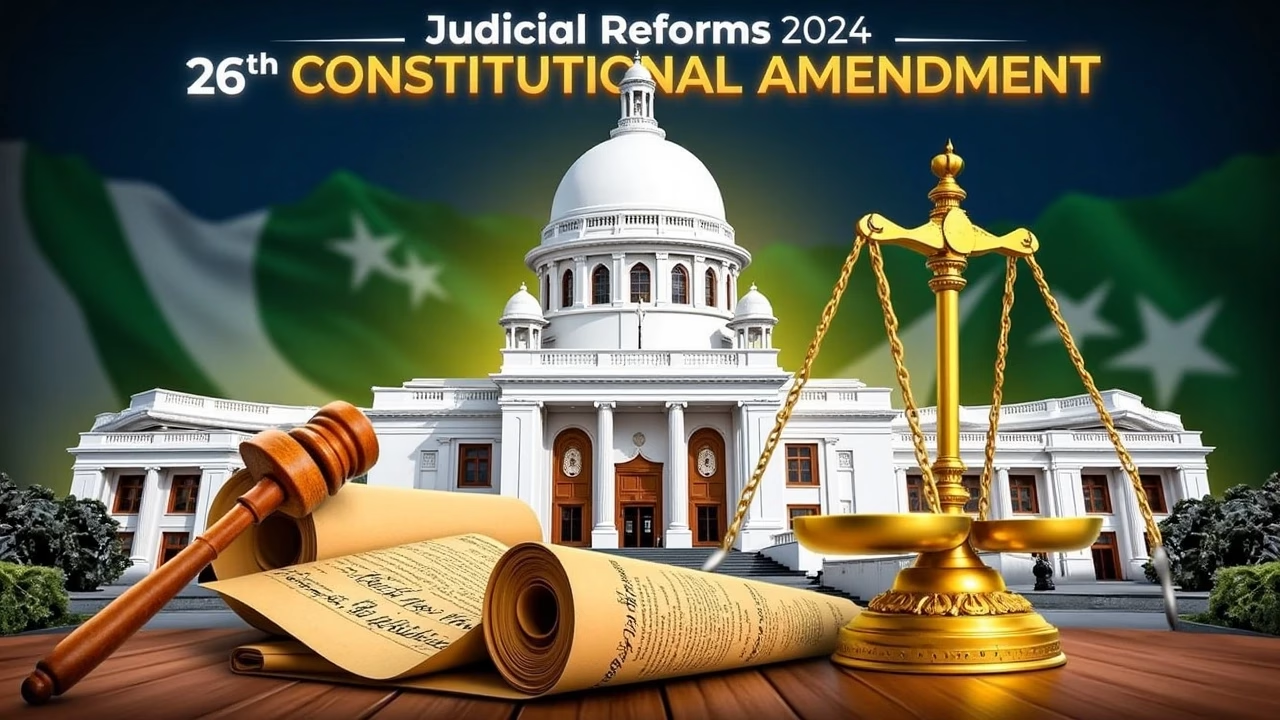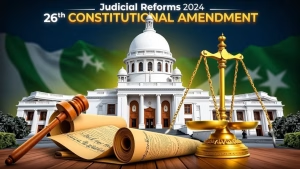
26th Constitutional Amendment of Pakistan, passed in 2024, which reshaped judicial appointments, curtailed suo motu powers, and introduced constitutional benches. Learn its features, pros, and criticisms in this detailed analysis.
26th Constitutional Amendment, 2024
The 26th Constitutional Amendment of Pakistan, passed in 2024, is one of the most debated legislative measures in recent constitutional history. Marketed as a “constitutional package” aimed at judicial reforms, it was passed with a two-thirds majority in both Houses of Parliament. While its proponents claim it improves transparency, democratizes the appointment of judges, and ensures accountability, its critics view it as a calculated attempt by the executive to curtail judicial independence and consolidate political control over the judiciary.

Salient Features of the Amendment
1. Appointment of the Chief Justice of Pakistan (CJP):
-
Earlier, the most senior judge of the Supreme Court automatically became CJP.
-
Now, a Special Parliamentary Committee will recommend one name from the three senior-most judges, which the Prime Minister will forward to the President.
-
The CJP’s tenure is now fixed at three years, notwithstanding the retirement age of 65.
2. Judicial Appointments:
-
The Judicial Commission of Pakistan (JCP) will continue to play a role, but its nominations now go directly to the Prime Minister.
-
Parliament has been given a greater role through a 12-member Special Parliamentary Committee with proportional representation of all parties.
-
For the High Courts, the head of Constitutional Benches replaces the “most senior judge” in the JCP.
-
Minimum age for High Court judges reduced from 45 to 40 years.
3. Supreme Court’s Jurisdiction:
-
Suo motu powers curtailed: the SC cannot initiate cases on its own beyond the contents of filed applications.
-
Appeals from High Courts are now limited to disputes involving a minimum threshold of one million rupees (earlier Rs. 50,000).
4. Constitutional Benches:
-
The amendment mandates the establishment of Constitutional Benches in both the Supreme Court and High Courts.
-
These benches will exclusively hear constitutional and politically significant cases.
-
The “Head of Constitutional Benches” in High Courts replaces the most senior judge in the JCP.
-
Aim: to institutionalize specialization in constitutional adjudication, reduce pendency, and streamline routine litigation in other benches.
-
Critics argue this move may fragment the judiciary, centralize sensitive matters under politically influenced judges, and diminish the collective authority of the SC’s full bench.
5. Performance Evaluation of Judges:
-
Annual performance evaluation of High Court judges introduced.
-
Inefficient judges may be reported to the Supreme Judicial Council for removal.
6. Federal Shariat Court & CII Reforms:
-
Appeals in Shariat Court matters to be disposed of within 12 months.
-
Council of Islamic Ideology (CII) references can now be initiated by one-fourth members of an assembly (earlier two-fifth).
7. Fundamental Rights:
-
A new Article 9A guarantees the “Right to a Clean, Healthy, and Sustainable Environment.”
8. Other Notable Changes:
-
Deadline for complete elimination of Riba set at January 1, 2028.
-
Expanded expenditure from the Federal Consolidated Fund to cover judicial bodies.
-
Provisions regarding oath-taking, continuation of Election Commission members, and awards of the President were also amended.
Critical Concerns Regarding the 26th Constitutional Amendment
1. Politicization of the CJP’s Office:
-
Fixing a three-year term and requiring selection from the top three senior judges enables executive influence.
-
Historically, automatic seniority provided neutrality and continuity.
2. Erosion of Judicial Independence:
-
Greater parliamentary control over appointments undermines the separation of powers.
-
Prime Minister’s central role in forwarding judicial names risks turning appointments into political bargains.
3. Weakening of the Supreme Court:
-
Removal of suo motu powers restricts the SC’s ability to enforce fundamental rights proactively.
-
Creation of Constitutional Benches may dilute the SC’s authority, placing critical questions in smaller, politically influenced benches.
4. High Courts’ Autonomy Curtailed:
-
Their suo motu jurisdiction was removed.
-
Transfer of constitutional cases only to designated benches limits judicial independence.
5. Conflict with Salient Features Doctrine:
-
In Mahmood Khan Achakzai Case and District Bar Case, the SC emphasized that independence of judiciary, federalism, and separation of powers are unalterable features of the Constitution.
-
By compromising judicial independence, the 26th Amendment risks being ultra vires.
6. Executive Dominance in the Name of Reform:
-
Though justified as a step for transparency and accountability, critics argue it institutionalizes executive control over judiciary.
-
Raises questions about whether Pakistan is drifting towards a “government constitutional court” rather than an independent judiciary.
Positive Aspects 26th Constitutional Amendment
-
Inclusion of the Right to Clean and Healthy Environment reflects modern constitutionalism and responds to global climate change concerns.
-
Structured system of performance evaluation of judges may enhance accountability.
-
Timeline for elimination of Riba provides policy clarity.
-
Introduction of Constitutional Benches may help reduce backlog and allow the SC to focus on routine litigation.
Conclusion
The 26th Constitutional Amendment represents both reform and regression. On one hand, it introduces long-demanded reforms such as judicial performance evaluation, parliamentary involvement in appointments, and recognition of environmental rights. On the other, it significantly reduces judicial independence by empowering the executive and legislature in judicial matters, limiting suo motu jurisdiction, and politicizing the appointment of the Chief Justice.
In constitutional theory, the amendment shakes the principle of trichotomy of powers. If challenged, it may face scrutiny under the Salient Features Doctrine laid down by the Supreme Court. For students of constitutional law, the amendment is a case study in how reformist rhetoric may cloak attempts at institutional capture. Its ultimate fate—whether it strengthens constitutional democracy or undermines judicial independence—will depend on how it is implemented and interpreted by the judiciary itself.
Relevant Reads
What is the 26th Constitutional Amendment?
Constitution of the United Kingdom, UK
Unpacking the 26th Constitutional Amendment of Pakistan
Admin at The Pakistan Gazette

